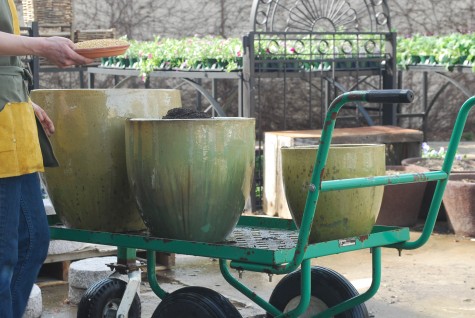I enjoy doing spring plantings for my clients. It gives me a chance to get into the garden early, and assess how everything fared over the winter. This winter was a breeze, but for a cruelly early break in the weather in March. It remains to be seen how Michigan’s fruit and berry crops will be affected. It was disconcerting to see that this pair of crabapple espaliers had long since bloomed out, and set leaf in mid-April, but I am happy about how they look.
This garden is graced by a gingko of great size. The entire layout and landscape of the house was organized around this tree. The groundcover is finally starting to fill in. It will not be so much longer before the boxwood completely obscures the wall. A grand old plant such as this one needs little more than a big open space around it.
It is possible to arrange for a great spring planting months ahead of time. Clusters of yellow tulips were planted in the fall; the pansies were planted over top. Fall planting of pansies may seem like an exercise in futility, given that winter is not far off, but newer strains of pansies are proving quite hardy. The clear sky series of pansies-especially tough. The pansies came up lush and thick this spring, and were in full flower on April 10. This garden had quite the jump on spring.
Planting pansies and violas in ground in the spring is not nearly as prevalent as what it once was-I am sorry for this. The spring season lasts just as long as any of the others. Tulips don’t present much in the way of foliage at ground level, so they are a perfect candidate for a little company. I also find that working with color in the spring is very tough-if I don’t have the names and faces right in front of me. This mix that features a rose pansy will look great with the red/pink/rose and white pansy mix. This is the ideal time to blob them in-I don’t plant everywhere. I plant where I can see dirt.
This picture was taken from the perspective of a 9 year old-any adult walking by will see the dirt spaces on the edge thickly planted with pansies. That color at ground level adds a whole other dimension to the idea of spring garden.
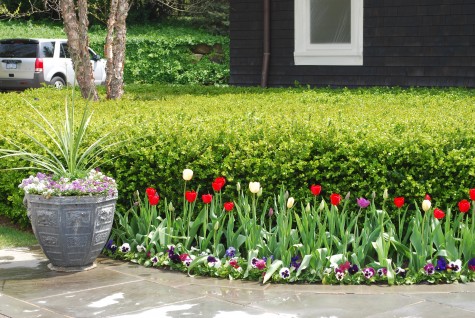
Of course we plant the attending pot for spring. This landscape is very simple. Its beauty is all about the weather, and the seasons. This small planting of flowers says all that needs to be said about spring.
,
I hate to see any pot sit empty-waiting. In another month, this planting will overflow this big pot. The sweet peas planted in the center will completely cover the tree of heaven branches in the center. Stick support? The English call a flexible stick that props up this or that in the garden a withy, or withe. Withies-a natural and much less obtrusive version of a galvanized metal peony ring. Slated to trail over the edge, a lime yellow sedum called Ogon. The purple kale planted at the base of the sticks will grow considerably in size, before it bolts from the heat.
The curving shape of the tulips leads the eye right to this lead pot-imagine the disappointment, were it to be empty. A pansy mix similar to what rings the pot borders the tulips. The front door seems so much more welcoming.
Once the pots are planted up, and the pansy border added, these tulips make a much stronger statement. They have a community of like minded spring friendly plants. I do have another client whose wild flower garden goes right up to her front door. At this time of year, it it is breathtakingly understated. That garden would not work for me at home, nor would it work here. Every property and house with a gardener in charge makes for an entirely individual celebration of the spring.
The side porch has a sentry pooch. I have seen him with hats, bandanas, necklaces and sunglasses. Sometimes there is a pumpkin on his head. You have it right-there are kids who live here. But for spring, a bucketful of lavender and a few pansies provide just the right touch-welcome, spring.
I saw these at a nursery yesterday. Irresistable, this.


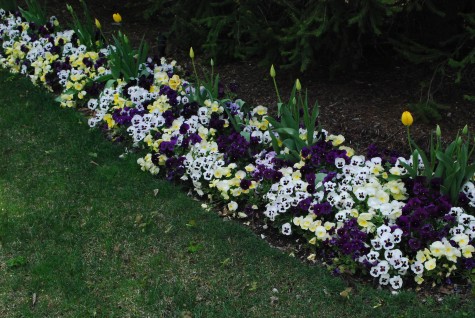
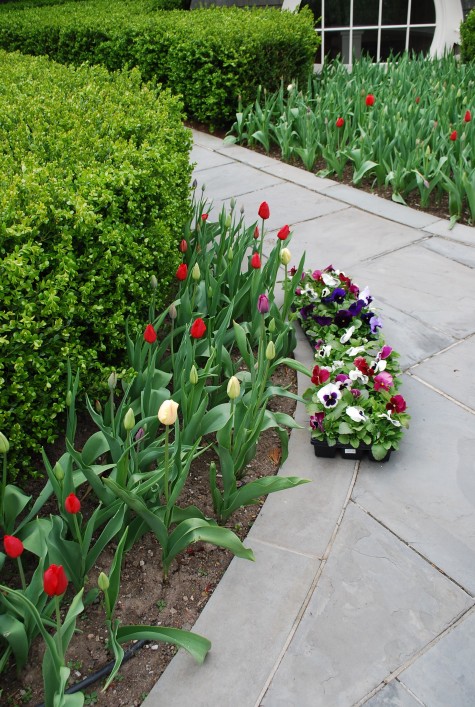
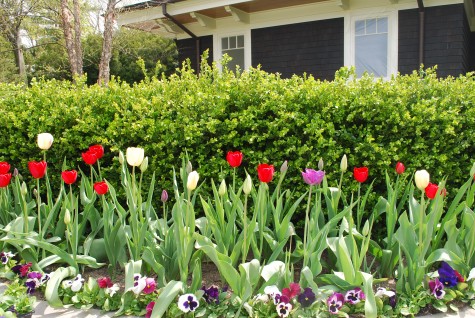
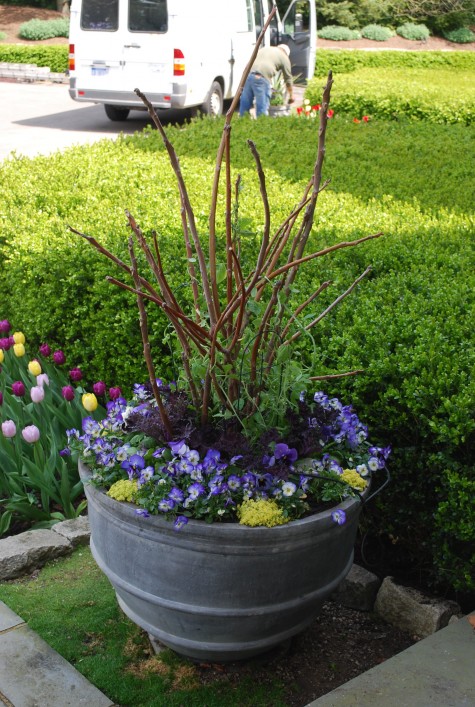

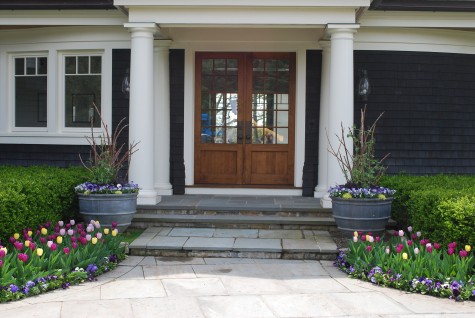
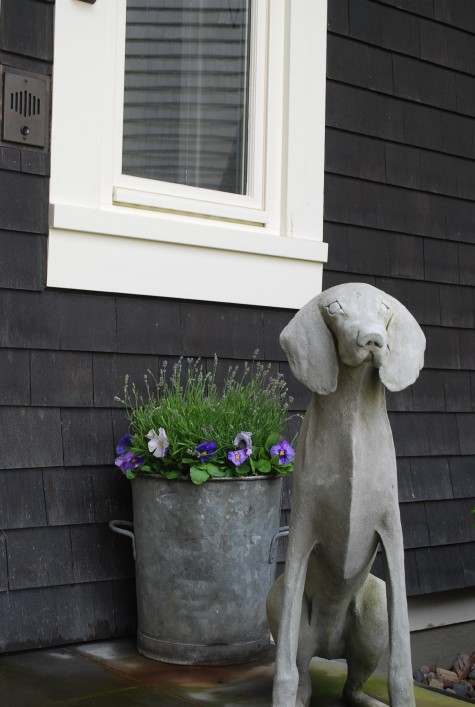
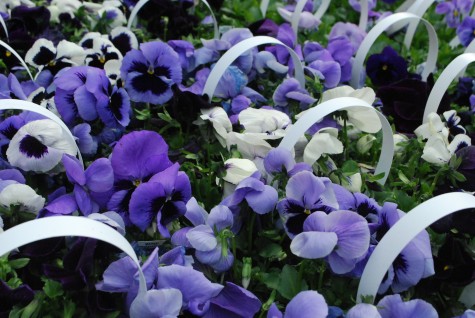
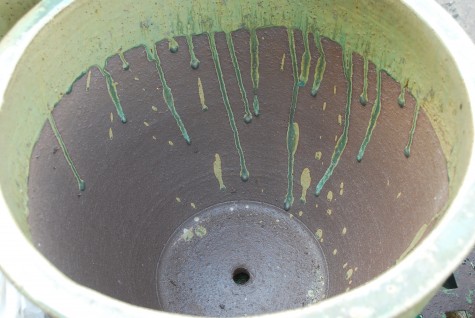
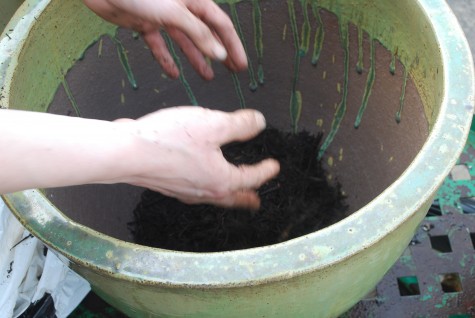
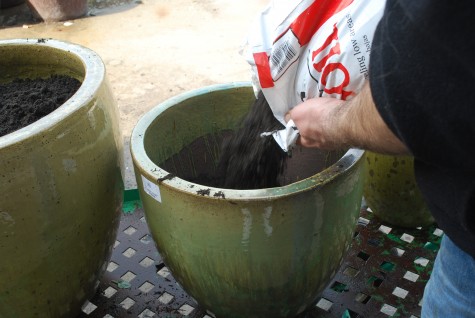 Perhaps even more important-the soil. Every gardener has a mix-I am no exception. I like a heavy soil, leavened with lots of compost and a big dollop of sand. Though plenty of garden centers sell giant bags of peat based “planting media”, I am a fan of topsoil. As in the closest thing to good garden dirt that is available.Peat based plant mixes are light-you can carry a giant bag to your car. But peat based planting media implies a professional grower on the other end who will feed that sterile soil at whatever parts per million it needs to produce good plants. My dirty little secret-good and hefty soil is essential for great plantings. A compost based soil that does not dry out too fast, that has nutrients, is perfect for garden variety gardeners. I am no fan of hauling forty pound bags of soil around-so I farm that job out to whomever I can persuade to help me. This is worth the trouble-making sure the pots get filled with great soil.
Perhaps even more important-the soil. Every gardener has a mix-I am no exception. I like a heavy soil, leavened with lots of compost and a big dollop of sand. Though plenty of garden centers sell giant bags of peat based “planting media”, I am a fan of topsoil. As in the closest thing to good garden dirt that is available.Peat based plant mixes are light-you can carry a giant bag to your car. But peat based planting media implies a professional grower on the other end who will feed that sterile soil at whatever parts per million it needs to produce good plants. My dirty little secret-good and hefty soil is essential for great plantings. A compost based soil that does not dry out too fast, that has nutrients, is perfect for garden variety gardeners. I am no fan of hauling forty pound bags of soil around-so I farm that job out to whomever I can persuade to help me. This is worth the trouble-making sure the pots get filled with great soil.

